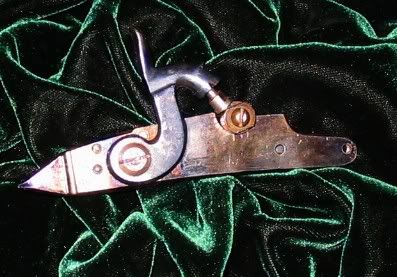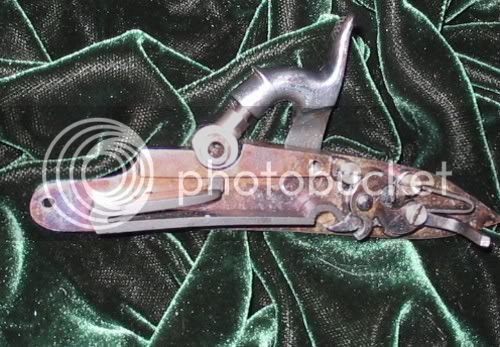I don't really want to harden anything, just like the colors. Does anyone have a home shop method to color case harden items like a steel buttplate or cap box? I have used Kasenit(?) to harden steel but it leaves a dull gray color, what I want is the rainbow type colors.
-
Friends, our 2nd Amendment rights are always under attack and the NRA has been a constant for decades in helping fight that fight.
We have partnered with the NRA to offer you a discount on membership and Muzzleloading Forum gets a small percentage too of each membership, so you are supporting both the NRA and us.
Use this link to sign up please; https://membership.nra.org/recruiters/join/XR045103
You are using an out of date browser. It may not display this or other websites correctly.
You should upgrade or use an alternative browser.
You should upgrade or use an alternative browser.
color case hardening
- Thread starter crockett
- Start date

Help Support Muzzleloading Forum:
This site may earn a commission from merchant affiliate
links, including eBay, Amazon, and others.
Crockett: When I built my Reading County rifle, I made it a convertable style. This is the Precussion lock for that rifle, and like you, I like color case colors.

This is what the lock looks like in normal light

A little different angle gets some of the glare off of the picture.

If you use this method, the inside of the lockplate gets colored too. If you don't like that, you can remove the color by buffing, or using a fine abrasive like Wrights Silver Polish.
As you know, when steel is heated, it turns different colors, depending on how hot it gets.
The colors are Yellow (430), Straw (470), Brown (500), Purple (540) and Blue (570 degrees F).
To do this coloring, the lock plate has to be stripped of all of the pieces and polished.
A method used has to apply the heat to a very small area.
I used a propane torch which is made for small jobs like jewelry and hobbies. It is held in the hand like a pencil and has a hose and connector to screw onto the propane bottle. The flame is adjusted by a knurled ring which is located right where your fingers are.
Using a bright light so I could see the colors developing, I applied the heat to the outer surface in stripes from the top of the lock to the bottom. When the steel started to turn blue, I would quench the lockplate in water to keep the hot zone from spreading. I then moved on to the next zone and repeated the proceedure.
When finished, I coated the locks surfaces with Sheath gun oil for protection.
Although the coating isn't very durable, I did this about 5 years ago and it still looks good to me.
You might notice the bridle is also colored to match the interior of the lockplate.
The mainspring, sear spring, and tumbler are not treated, and I suggest that you don't use this method on them. It will soften them and effect their durability.
Hope this gives you some ideas.

This is what the lock looks like in normal light

A little different angle gets some of the glare off of the picture.

If you use this method, the inside of the lockplate gets colored too. If you don't like that, you can remove the color by buffing, or using a fine abrasive like Wrights Silver Polish.
As you know, when steel is heated, it turns different colors, depending on how hot it gets.
The colors are Yellow (430), Straw (470), Brown (500), Purple (540) and Blue (570 degrees F).
To do this coloring, the lock plate has to be stripped of all of the pieces and polished.
A method used has to apply the heat to a very small area.
I used a propane torch which is made for small jobs like jewelry and hobbies. It is held in the hand like a pencil and has a hose and connector to screw onto the propane bottle. The flame is adjusted by a knurled ring which is located right where your fingers are.
Using a bright light so I could see the colors developing, I applied the heat to the outer surface in stripes from the top of the lock to the bottom. When the steel started to turn blue, I would quench the lockplate in water to keep the hot zone from spreading. I then moved on to the next zone and repeated the proceedure.
When finished, I coated the locks surfaces with Sheath gun oil for protection.
Although the coating isn't very durable, I did this about 5 years ago and it still looks good to me.
You might notice the bridle is also colored to match the interior of the lockplate.
The mainspring, sear spring, and tumbler are not treated, and I suggest that you don't use this method on them. It will soften them and effect their durability.
Hope this gives you some ideas.
i talked to these guys and for bout 100.00 bucks they will do my barrel, tang and lock..........................bob
:thumbsup:
http://restorationfirearms.com/
:thumbsup:
http://restorationfirearms.com/
NevadaBlue
Pilgrim
- Joined
- Nov 8, 2004
- Messages
- 3
- Reaction score
- 0
Thanks for the tips and the link. Zonie, I have a friend that built a convertible rifle/lock. Could you post more pics of the conversion? Looks interesting. If you have already posted some, sorry, I'm new and haven't snooped around much yet.
tommyinTexas
32 Cal.
- Joined
- Sep 12, 2003
- Messages
- 10
- Reaction score
- 0
In Bill Holms book of prototype firearms he advises using tincture of benzoin (probably misspelled its been a while) and brushing it on the surface of the metal letting it dry. You then use a torch (he states propane does not heat up quick enough) and heating up until it gets to the color you want then you quench it and proceed to the next area adjacent to the last and heat it. This method heats up quickly and does not soften metal that has been factory hardened. This is only for colors not for hardening. Bill stated that this method produced colors better than the real thing. This is from memory and should be confirmed before you try it. Bill Holms has written many books on firearm construction.
Not to answer my own question but in researching this I came across a formula where potassium nitrate(saltpeter) is dissovled in the quenching liquid.This is supposed to create all sorts of brillant colors. Has anyone tried this? Where would you buy Potassium Nitrate? :what:
tommyinTexas
32 Cal.
- Joined
- Sep 12, 2003
- Messages
- 10
- Reaction score
- 0
If you have an Old style drug store close I would ask them
If you google it, several suppliers will come up.
I didn't look closely, but my guess is that the Dept of Homeland Security and other allied federal agencies might be keeping close tabs on sales. KNO3 is an oxidizer for explosives and is a principal ingredient of black gunpowder.
-d
I didn't look closely, but my guess is that the Dept of Homeland Security and other allied federal agencies might be keeping close tabs on sales. KNO3 is an oxidizer for explosives and is a principal ingredient of black gunpowder.
-d
Similar threads
- Replies
- 23
- Views
- 1K
- Replies
- 128
- Views
- 6K
- Locked
- Replies
- 20
- Views
- 2K
- Replies
- 0
- Views
- 150



